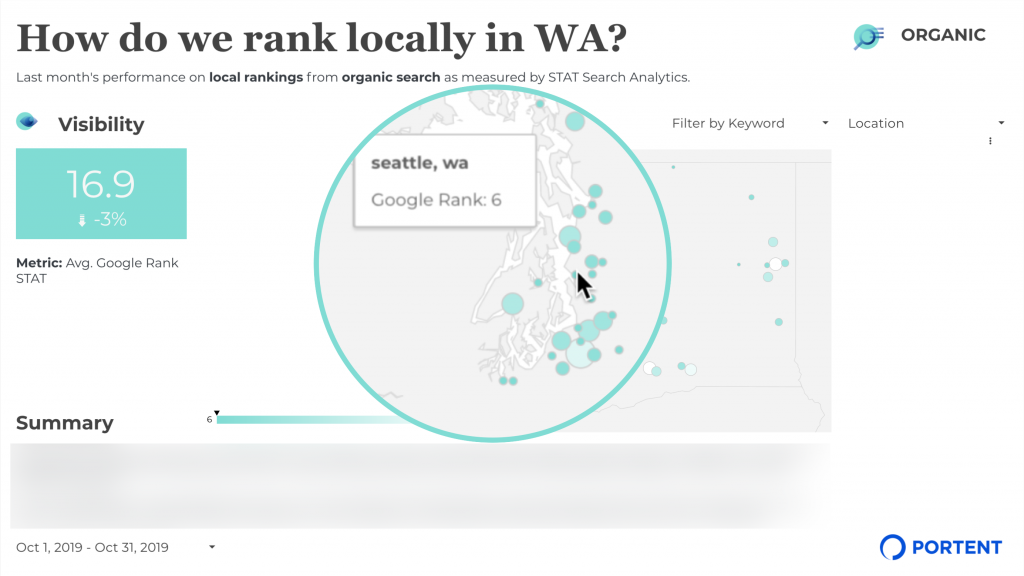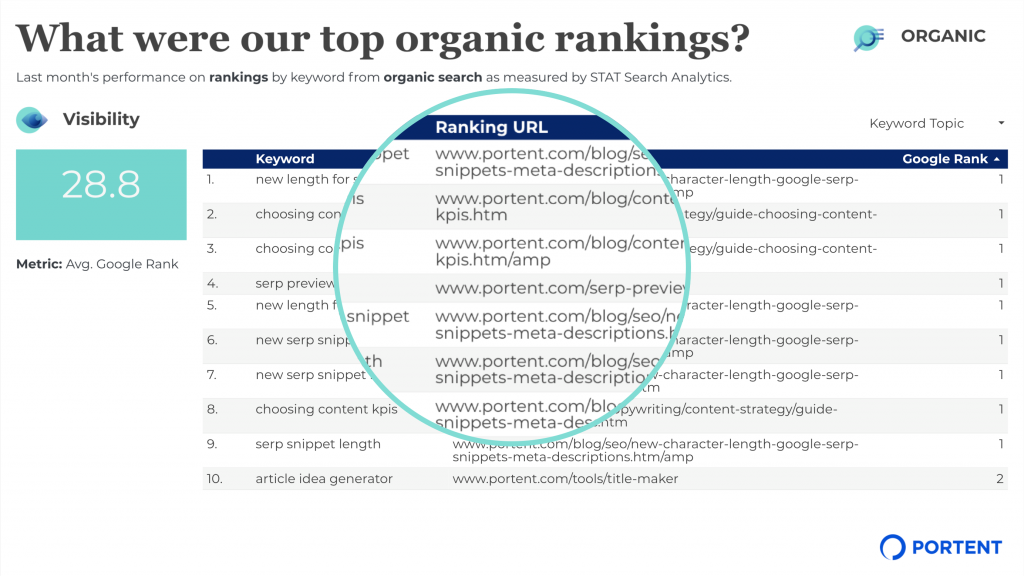Updated on November 21, 2019, to include new examples around measuring share of voice and other insights.
Let’s face it. Rankings are not a great SEO metric anymore for a myriad of reasons. To name a few:
- Results are too localized and flavored by previous searches
- Google is constantly
messing withfine-tuning their algorithm - Ranking may get you traffic, but it doesn’t guarantee you sales
These are widely accepted facts in the search industry, but to paraphrase one of our clients:
“Perception is the reality for a lot of business owners who wonder why the shop across the road shows up #1 for ‘widgets,’ and they don’t.”
Even so, search experts know better. Chasing keyword rankings for vanity’s sake is a fool’s errand, especially when there’s profitable traffic to be had elsewhere.
But there are still great uses for ranking data beyond just chasing a single glory phrase. In this post, I’ll walk you through four of them and the reports we’re using at Portent to address SEO progress through ranking.
1. The Ranking Map
The age of personalized search has made local ranking factors way more prevalent. Your storefront’s proximity to the person searching, the accuracy of your store listings in the search engines, your content’s relevance for a given city or neighborhood name, and ratings in the marketplace are a big deal now.
So instead of using ranking data for individual keywords, many ranking tools will allow you to see rank for target keywords in a given location. When you aggregate those numbers across a handful of important keywords for your business, you get a ranking map like this one:

2. The Keyword Funnel
Another valuable way to use ranking data is by grouping your keywords based on the part of the customer journey a person is in when they search for it.
It’s the traditional Awareness > Consideration > Conversion marketing funnel we’re all used to, but for search.
Here’s an example of how you would assign keywords to each part of the funnel:
Awareness – “widgets”
Consideration – “acme widgets vs. other widgets”
Conversion – “where to buy acme widgets”
You’d repeat this process for all of the keywords you’re targeting and then take your average rank and the total search volume available in each part of the funnel.

This helps you understand what type of content you need most in each keyword theme: Educational content for people just getting to know your brand, comparative content to help them understand the nuances of various products in the marketplace and why they should buy it from you, or promotional content to share your latest deal when your prospect is ready to buy.
3. Keywords by Landing Page
Since web analytics platforms no longer get granular keyword data from search engines, it’s important to understand which page is obtaining the ranking for a given keyword and whether or not that’s the most appropriate page for somebody searching to land on.
Then you can cross-reference that page’s performance (I recommend using the Landing Pages report in Google Analytics for this) for the conversions you care most about and see if perhaps you’re not attracting the right audience to that content.

4. Share of Voice by Keyword Group
Individual keyword rankings don’t always paint the clearest picture of how well you’re ingrained in the minds of customers in the marketplace. It also doesn’t show you how much ground you’re covering compared to key competitors in your industry.
STAT, our rank tracking tool of choice, has its own formula for calculating Share of Voice (SOV) based on typical click-thru rate (CTR) in a given ranking multiplied by the Search Volume available for a keyword or group of keywords.
Measuring the change in SOV over time is a fantastic way to see how broader content and link building efforts are helping you gain ground in the SERPs for phrases you really care about.

To Recap
Remember, don’t fall into the trap of gunning for individual rankings. But there are so many creative ways we can repurpose this data to help us make better decisions as search marketers, that it’d be a shame not to integrate some in your daily workflow.










Great post! I absolutely agree about the use of Landing Pages reports in Google Analytics. The ranking map is also a great tool.
Great perspective!
Keyword reports are also useful for gauging how the content has been processed; do we see a robust set of relevant keywords trending toward the first page of results, or just a bunch of random keywords that may indicate the content is unfocused and poorly structured? Why are branded keywords missing? Or why is the site suddenly ranking for Viagra?
It would be wonderfully helpful to see how you prepare the reports for local ranking – that data can be difficult to distill!
The Keyword Map is how we usually approach local ranking. Granted, its granularity is limited to how specific your ranking tracking tool can get. STAT goes down to the city level of granularity. Neighborhood or Zip Code-level tracking is difficult, but not impossible to achieve, depending on what you pass into GA.
Hello! Helpful information. Thanks for sharing great tips.
Good Day MICHAEL! Thanks for sharing this helpful guide in a very brief way. KW ranking report is one of the most important part that need every company and client on time and with proper way. I’m doing SEO for my client’s site but I’ve plenty of issue regarding kw ranking report cause ahref showed only ranked while the client expects those too who he mentioned as primary kw. you explained very well and cleared each step excellently is there any any tool that can generate auto kw ranking report on monthly basis?
Hi Henry,
We use STAT Search Analytics (recently acquired by Moz) to power all the raw keyword ranking data to build the dashboards described in this post. But if you’re looking for a free alternative, you could just use Data Studio’s native connector to Search Console, with the understanding that the avg. ranking data is directional and not 100% accurate.
This is really a great article and a great read for me. It’s my first visit to your blog and I have found it so useful and informative specially this article. Thank you
this is a nice article, thanks for sharing.
this is helpful, thanks for sharing this article.
Thank you for sharing a helpful post. I’m definitely going to come back here more often. Thank you so much for taking the time to share this wonderful post with us.